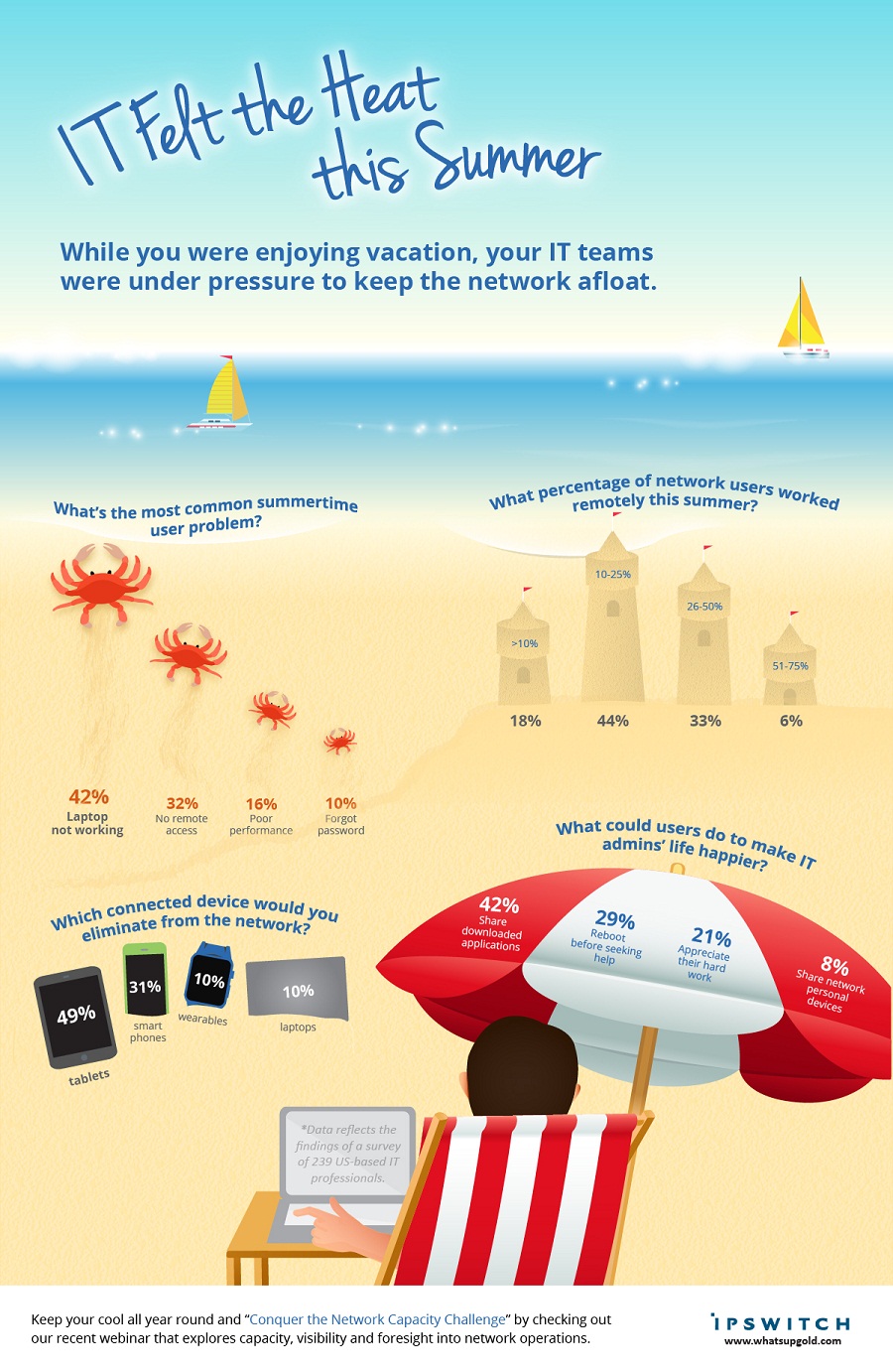IT pros really felt the heat this summer as they kept networks buzzing along for remote workers having fun in the sun, according to Ipswitch's inaugural Summertime Blues Survey. The study confirmed that most organizations see a significant expansion in the number of remote workers throughout the summer months, which can make the job of a network manager or SysAdmin increasingly more difficult.
Some key findings from the survey include:
■ Remote workers with malfunctioning laptops create excess strain: Forty-two percent of IT pros surveyed named malfunctioning laptops as the top culprit, followed by network connectivity issues (32 percent) and poor application performance (16 percent).
■ An uptick in wireless devices accessing the network creates seasonal BYOD headaches: When asked what type of device they’d like to see eliminated from use on the corporate network, 49 percent of all IT pros surveyed chose tablets, followed by smartphones coming in at 31 percent.
■ Appreciation and empowerment go a long way: Nearly one third (29 percent) of IT pros said they’d most appreciate if an employee would reboot their computer before seeking IT assistance. An additional 32 percent of IT pros would like the ability to choose and buy technology, while 25 percent wanted to have X-ray vision to figure out the source of the problem.
■ Vacation time for IT pros comes with baggage: One quarter of IT pro respondents (25 percent) indicated that their summer vacation was more restricted than other departments within their organization. Even when on vacation, nearly a third of IT pros (28 percent) admitted that they will be stressed over the state of their network while they are away.
Jeff Loeb is CMO at Ipswitch.

The Latest
Industry experts offer predictions on how NetOps, Network Performance Management, Network Observability and related technologies will evolve and impact business in 2025 ...
In APMdigest's 2025 Predictions Series, industry experts offer predictions on how Observability and related technologies will evolve and impact business in 2025. Part 6 covers cloud, the edge and IT outages ...
In APMdigest's 2025 Predictions Series, industry experts offer predictions on how Observability and related technologies will evolve and impact business in 2025. Part 5 covers user experience, Digital Experience Management (DEM) and the hybrid workforce ...
In APMdigest's 2025 Predictions Series, industry experts offer predictions on how Observability and related technologies will evolve and impact business in 2025. Part 4 covers logs and Observability data ...
In APMdigest's 2025 Predictions Series, industry experts offer predictions on how Observability and related technologies will evolve and impact business in 2025. Part 3 covers OpenTelemetry, DevOps and more ...
In APMdigest's 2025 Predictions Series, industry experts offer predictions on how Observability and related technologies will evolve and impact business in 2025. Part 2 covers AI's impact on Observability, including AI Observability, AI-Powered Observability and AIOps ...
The Holiday Season means it is time for APMdigest's annual list of predictions, covering IT performance topics. Industry experts — from analysts and consultants to the top vendors — offer thoughtful, insightful, and often controversial predictions on how Observability, APM, AIOps and related technologies will evolve and impact business in 2025 ...
Technology leaders will invest in AI-driven customer experience (CX) strategies in the year ahead as they build more dynamic, relevant and meaningful connections with their target audiences ... As AI shifts the CX paradigm from reactive to proactive, tech leaders and their teams will embrace these five AI-driven strategies that will improve customer support and cybersecurity while providing smoother, more reliable service offerings ...
We're at a critical inflection point in the data landscape. In our recent survey of executive leaders in the data space — The State of Data Observability in 2024 — we found that while 92% of organizations now consider data reliability core to their strategy, most still struggle with fundamental visibility challenges ...












